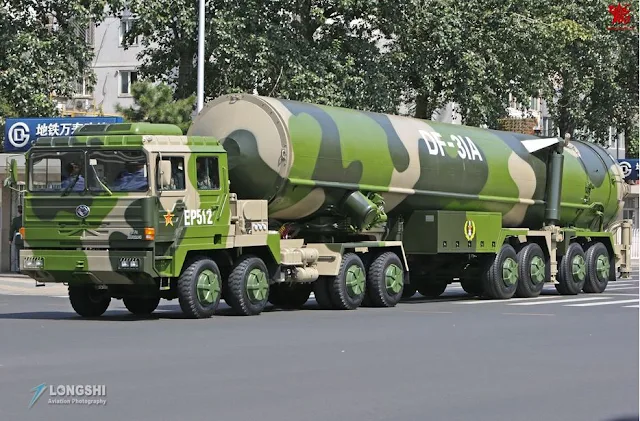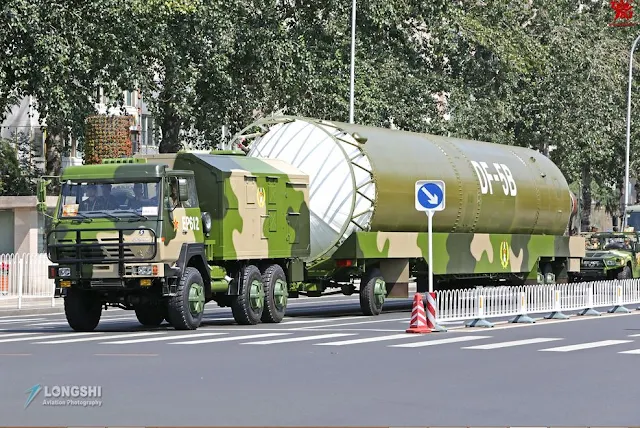By David Xia In the 3 September Victory Day Military Parade in Beijing that marked the 70th anniversary of the end of WWII, the Second...
By David Xia
In the 3
September Victory Day Military Parade in Beijing that marked the 70th
anniversary of the end of WWII, the Second Artillery Corps (SAC) of the
People’s Liberation Army (PLA) formed six formations in the ground mobile
column, featuring seven models of its DF — “Dong Feng” family of theatre and
strategic missiles. These missiles cover all categories of the Second Artillery
Corp's current inventory, ranging from short to intercontinental range, from
ballistic to cruise missiles, and from nuclear to conventionally armed.
The missiles
featured in the parade include the DF-15B short-range ballistic missile (SRBM),
the DF-16 SRBM, the DF-21D anti-ship ballistic missile (ASBM), the DF-10A land-attack
cruise missile (LACM), the DF-26 intermediate-range ballistic missile (IRBM),
the DF-31A intercontinental ballistic missile (ICBM), and the DF-5B ICBM. Among
them, only the DF-15B and DF-31A were featured in the previous parade in 2009,
whereas the remainders were all unveiled to the public for the first time.
DF-15B
Short-Range Ballistic Missile
The DF-15 is a
conventionally armed, solid-fuel, mobile launched SRBM system, designed by the
CASC Academy of Aerospace Solid Propulsion Technology (AASPT, or 4th Academy).
First introduced in the late 1980s, the missile was originally intended for the
export market under the designation M-9, but was subsequently adopted by the
PLA Second Artillery Corps in the 1990s for conventional strike role. The DF-15
became famous during the 1995—96 Taiwan Strait Crisis, when the PLA launched a
number of DF-15s into the public waters near Taiwan.
The basic
variant DF-15 was essentially a single-stage rocket with a primitive inertial
guidance package (250–300 m CEP), making it only suitable for attacking large
fixed area targets such as an airport or naval base. The PLA has subsequently
introduced the improved DF-15B that featured sectored control fins, GPS
midcourse correction, terminal guidance, and control fins on the re-entry
vehicle. Its accuracy was said to have dramatically improved to a CEP of 50–100
m.
First unveiled
to the public in the National Day Military Parade in 2009, the DF-15B is
carried on a four-axle transporter-erector-launcher (TEL) built by the CASC
Tai’an Special Vehicle Corporation. The missile carries a single 500 kg
conventional warhead and has a maximum range of 600–800 km. In time of crisis
the missile system could be quickly mobilised from bases to launch locations
via railway. The TEL then carries the missile to the launch site. The 2010 U.S.
DoD Report on the PRC Military Power estimated that 350–400 missiles and 90–110
launchers were in operational deployment with the PLA Second Artillery Corps,
though this number may have increased significantly since then.
DF-16 Short
Range Ballistic Missile
The second SRBM
system featured in the parade was the DF-16 (CSS-11), a new design unveiled to
the public for the first time. Jane’s Strategic Weapon Systems first reported
in September 2012 that China was developing a new short- to medium-range
ballistic missile designated DF-16 as a successor to the older DF-11 (CSS-7,
M-11) and DF-15. The 2015 U.S. DoD Report on the PRC Military Power mentioned
the DF-16/CSS-11 for the first time, stating that it was in operational
deployment.
The DF-16 was
described as a conventionally armed, mobile-launched, two-stage, solid-fuel
ballistic missile with a range of 800—1,000 km, enough to reach whole of Japan
as well as U.S. military bases in Okinawa. The missile is expected to be fitted
with an Inertial Navigation System (INS) coupled with GPS mid-course guidance,
as well as a terminal guidance system to achieve a CEP of 5—10 m, enough for
precision strike against a point target. The missile is carried on a five-axle
Sanjiang Corporation TEL as opposed to the four-axle TEL used by the DF-11 and
DF-15, indicating a significant increase in launch mass.
DF-21D Anti-Ship
Ballistic Missile
The 17th
formation of the ground mobile column in the parade featured the DF-21D (CSS-5
Mod 5) anti-ship ballistic missile (ASBM), the world’s first weapons system
potentially capable of targeting a moving aircraft carrier strike group (CSG)
from long-range, land-based mobile launchers. China has long been rumoured to
be developing its DF-21 (CSS-5) medium-range ballistic missile (MRBM) into a
unique anti-ship weapon system dubbed the “carrier killer”. A U.S. Navy senior
official revealed in December 2010 that the Chinese ASBM system had reached
equivalent of “Initial Operational Capability” (IOC), but the Chinese military
had never officially confirmed the existence of such a weapon system until now.

According to
limited public information sources on the ASBM system, the missile is launched
from a land-based TEL and flies over a distance of 1,500—2,000 km to strike
naval targets. The missile would initially rely a system of systems consisting
of land-based over-the-horizon radar as well as air- and space-based sensors to
locate and track its target. Once the missile re-enters atmosphere, it would
switch to its onboard optical/radar terminal guidance and approach the target
at a terminal velocity of Mach 6 or above, making it highly difficult to be
intercepted by enemy’s air/missile defence system.
A test launch of
the DF-21D against a land target was reportedly conducted in the Gobi Desert in
January 2013. Some analysts still have doubts over the effectiveness of the
ASBM system against a moving target in the sea, and whether the missile’s ‘kill
chain’ involving multiple land-/air-/space-based sensors can survive enemy
countermeasures until the missile reaches its target. Nonetheless, the official
debut of the DF-21D suggests that the PLA is confident enough to deploy the
missile for operational use.
DF-10A
Land-Attack Cruise Missile
The 18th
formation featured the DF-10A LACM, possibly a derivative of the CJ-10 (Chang
Jian-10) LACM displayed during the National Day Military Parade in 2009 with
improved range and accuracy. Chinese military planners watched closely the
employment of the Tomahawk LACM by the U.S. military in Kosovo, Iraq, and
Afghanistan, and began to develop its own LACM in the late 1990s. The first
Chinese LACM design, reportedly designated DH-10 (Dong Hai-10), was believed to
have been developed from the Russian Kh-55 (AS-15 ‘Kent’) technology.
The DH-10 was
reported to be capable of delivering a 500 kg conventional warhead over a
distance of 1,500 km, with a CEP of 10 m. The missile was first delivered to
the PLA Second Artillery Corps in 2006 and was unveiled to the public for the
first time in the 1 October 2009 military parade under the designation CJ-10.
The DF-10A LACM featured in the 3 September military parade featured a new
four-axle TEL, and a slightly different arrangement in the layout of the
launcher boxes.

An air-launched version of the CJ-10,
under the designation of CJ-20, is being deployed by the PLA Air Force (PLAAF)
on its Xi’an H-6K medium-range bombers, which was also featured in the 3
September parade in its air display column. A shipborne version of the missile
was reported under test in 2012.
DF-26 Intermediate Range Ballistic
Missile
The most prominent revelation in the 3
September Military Parade was the DF-26 IRBM. The existence of this new missile
system was first revealed by the Washington Free Beacon website in March 2013.
The missile is a mobile-launched, two-stage, solid-fuel IRBM system capable of
delivering both conventional and nuclear warhead. The DF-26 was nicknamed the
“Guam Express”, referring to its estimated range of 3,500—4,000 km, enough to
reach the second island chain in the Western Pacific and U.S. military bases on
the island of Guam.
The most astonishing revelation about
the missile came from the commentator during the live TV broadcast of the
military parade, who said that the DF-26 could conduct precision strike against
both crucial land targets as well as medium and large naval vessels. The
introduction of a second conventional ASBM system has extended the outer edge
China’s layered defence posture against potential offshore threats far beyond
the previously estimated 1,500—2,000 km range offered by the DF-21D.
DF-31A
Intercontinental Ballistic Missile
The 20th
formation featured the DF-31A (CSS-9, Mod-2), a road-mobile, nuclear-armed,
three-stage, solid-fuel ICBM system that entered service with the Second
Artillery Corps around 2008. The missile was an improved variant of the DF-31
ICBM introduced in the 1990s. Despite the various speculations about the
DF-31A’s MIRV capability, it is believed that the missile only carries a single
1MT yield thermonuclear warhead, with an estimated range of 10,700~11,200 km.
The DF-31A was
first unveiled to the public in the National Day Military Parade in 2009. The
U.S. DoD Report on the PRC Military Power in 2009 estimated that around 15
missiles were in operational service with the Second Artillery Corps.
DF-5B
Intercontinental Ballistic Missile
The last
formation of the SAC featured the DF-5B (CSS-4 Mod 3) ICBM, a silo-based,
two-stage, liquid-fuel ICBM system with an estimated range of 10,000–13,000 km.
The original DF-5 developed in the 1970s was China’s first ballistic missile
system to be capable of reaching targets in North America. It also formed the
base rocket for China’s Chang Zheng (CZ, or Long March) 2/3/4 families of space
launchers. The missile was first displayed in the 1984 National Day Military
Parade.
The latest B
variant of the DF-5 is believed to have been given the Multiple Independently
Targetable Reentry Vehicle (MIRV) capability, with each missile carrying three
nuclear warheads. The U.S. DoD report on the PRC military power in 2015
revealed for the first time that China had begun to deploy the MIRV-equipped
DF-5B.
Conclusion
The seven missile
types displayed in the 3 September Military Parade reflect the PLA’s continuing
trend to develop and upgrade the conventional missile component of the Second
Artillery Corps, which was first created two decades ago and now several times
as large as the Corps’ nuclear arsenal. The conventional missile force provides
an operational-tactical and strategic capability in-theatre without the
political and practice constraints associated with nuclear-armed missiles.
Secondly, the
Corps’ emerging inventory of conventional anti-ship ballistic missile (ASBM)
and land-attack cruise missile (LACM) provides the PLA extra employment options
in its development of anti-access/anti-denial (A2AD) capability in the
Asia-Pacific region. In a potential escalation of a conflict in the Taiwan
Strait, the South China Sea, and the East China Sea, the PLA will be more
willing to launch a conventional missile strike against U.S. or its allied
forces and bases in the Western Pacific region, including potential ASBM series
against U.S. Navy aircraft carrier.
Thirdly, the
missiles in display do not represent all of the latest designs in the Second
Artillery Corps’ inventory. Some even newer missile models, notably the DF-41
(CSS-X-10) ICBM and the DF-31B (CSS-9, Mod 3), were absent in the parade and
may have been kept as ‘surprise guests’ for the National Day Military Parade in
2019.
About The Author:
David Xia of SinoDefence.com and can be reached through email - sinodefenceblog@gmail.com | Thomson Reuters Researcher ID : L-1240-2015

























